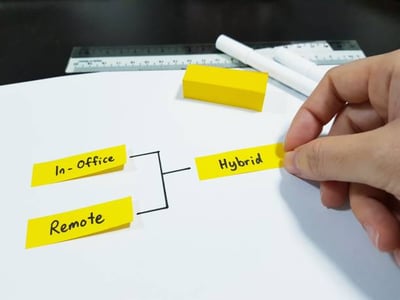October 21, 2022
 by Max Chopovsky / October 21, 2022
by Max Chopovsky / October 21, 2022

The workplace of today looks very different from that of a few years ago. The option for employees to work remotely was not the norm, and many companies relied on in-person experiences to fuel their corporate culture.
We all likely share a common experience of remembering life pre- and post-pandemic. And if you’re in a leadership role, it’s likely that you’ve never seen such a monumental shift in recent memory.
One of the biggest trends to come out of the pandemic is the concept of hybrid work, where companies and employees dictate a blend of working in an office and remotely. One of the biggest challenges of adopting a hybrid approach is developing and maintaining a strong corporate culture.
Having an excellent culture is non-negotiable for good leaders, so how can you do it for hybrid workplaces? I recently sat down with two executives for my podcast, Future of Work, to share some tips on how you can build the best culture for your hybrid employees.
Thinking back several decades, many considered corporate culture an afterthought. It turns out that, in fact, corporate culture not only matters but has a measurable impact on financial results.
The companies on Fortune’s 100 Best Places to Work For list underscore just how much of a difference company culture can make.
It’s helpful to consider how labor demands have shifted in the last few years. In early 2022, companies were coming to grips with the “Great Resignation,” where workers had all the leverage to find new employment if they weren’t satisfied. For the first time, companies needed their workers, not the other way around.
A thoughtful and substantial culture goes a long way toward keeping employees engaged and heard. Culture can be a driving force behind motivating workers to perform but also encouraging them to stick around.
What’s really changed is how we think about work. Going to an office every day was a universal experience, but working from home makes you take stock of how you prefer to work. People discovered that there are benefits to both in-person and remote work.
If you talk to almost any executive or HR professional, they can tell you that culture is crucial, but fostering one for a hybrid workplace is tricky. In-person experiences feel more communal and socialization happens more naturally.
Even just a few years ago, new hires could walk the floor of their new company to meet a couple of people and feel the energy and vibe of that environment. Fast forward to now and most new employees are unlikely to meet most of their co-workers if their company is hybrid or fully remote.
Companies look to hybrid work to create an environment that provides flexibility, efficiency, and higher productivity. The good news is that it is possible to develop a culture for hybrid workers that ultimately pushes the company forward.
On my podcast, Future of Work, I talk to industry experts and leaders to understand and explore the implications of what the future holds that includes the impact on culture, workspace design changes, product and tech innovations, and more.
In a recent episode, I sat down with Mike Gamson, CEO at Relativity, and Chris Gladwin, Co-founder and CEO at Ocient. I had a great conversation with them, and here are their five tips anyone can use to design a culture for a hybrid workforce.
Corporate culture starts and grows organically. For smaller companies with in-office attendance, this could be enough in pre-pandemic days. But not today.
“One of the big things we found with culture is that we had to be so much more intentional about it. We had to write it down, put it on slides, train people on it.”
Chris Gladwin
CEO, Co-Founder at Ocient
Chris acknowledges that back when everyone was in office, just being around others and having the option to talk to one another face-to-face just wasn’t possible with everyone working at home. So, they had to devise a way to make it so that the work still got done without falling back on those in-person interactions.
One technique used by Relativity and Ocient is meeting with new hires to explicitly lay the groundwork for conveying their culture. This can be virtual or in-person, but by acting intentionally, employees routinely get a reminder of the values that make up the culture.
Fewer people traveling to an office every day means that those serendipitous encounters with colleagues that can spark innovation or forge social connections happen far less often. But rather than focus on what they’re losing from hybrid work, companies must consider improving those in-person experiences and making them more meaningful.
Both Relativity and Ocient have rethought the role of their offices, seeing their physical spaces as crucial launch pads for work-related events.
“Our physical office spaces are now hosts for experiences. They host moments for our teams, employees, and customers.”
Mike Gamson
CEO at Relativity
From hosting quarterly meetups to customer briefings, the mindset has shifted from solely being a place to work to one that is central to meeting up in real life. Employees still have the choice to work in the way they choose if they still prefer a physical desk, but a strong case for the office is to enhance those in-person experiences.
At the beginning of the pandemic, many executives and leaders feared that forcing entirely digital communication would hurt any chances of employees connecting. This led to companies trying to recreate in-person experiences for the digital world, such as virtual happy hours.
As both Chris and Mike found out, some things don’t always translate perfectly from online to the real world. “A virtual happy hour was really hard to pull off for employees across the world,” said Chris. “We’re learning and finding out what works really well.”
However, this isn’t to say that socialization can’t happen digitally, you just need to lean into how your employees prefer to socialize. This can include emphasizing Slack channels that highlight topics unrelated to work or acknowledging employee achievements.
Tip: Create activities that encourage engaging with each other. For example, Chris shared how his company is experimenting with employee baseball cards which they can collect upon each new co-worker they meet. Gamification is just one method to encourage socializing in a hybrid environment.
Another pandemic revelation was employee choice. With unemployment returning to historic lows, knowledge workers have the freedom to explore their options if they feel their employer isn’t investing in the employee experience.
“As the balance of power has shifted from corporations to the talent, that balance of power is most evident in employee choice.”
Mike Gamson
CEO at Relativity
Referencing labor shortages for knowledge workers in recent years, Mike and Chris discuss that employees have more choices than ever. Corporations can resist all they want, but it’s crucial to respect, embrace, and support the variety of ways that employees prefer to work.
Some employees want to work from home. Some work best behind a desk in an office. The idea here is to validate what they want and show your employees that their preferences matter.
Working in an office or at home isn’t inherently better than the other. It’s difficult to prescribe one as the perfect solution for your workforce. The difference is realizing and appreciating that employees in a hybrid environment experience things differently.
Let’s say you run a company with both fully remote and in-office employees and you conduct several critical virtual meetings weekly. It might feel natural for all your in-office employees to hop on the call in the same conference room, whereas the remote employees have to log in virtually.
For those remote workers, you may not realize that there might be a feeling of exclusion, especially if the in-office workers are all interacting in real time. In this scenario, here are two things you can try to see if they help create a better experience for everyone:
Socializing in person is natural. You’re sharing the same physical space as another human being. This is how we were built to interact.
But in the post-pandemic world, employees want options when it comes to how they work. And yet, most companies don’t envision an entirely office-less future. So chances are, the hybrid workplace is here to stay.
You can create and foster a corporate culture for a complex work environment. It comes down to having a great understanding of your employees' diverse experiences and being extremely intentional with how you bring your culture to life.
The Future of Work podcast explores the questions and implications posed by the future of the office, company culture, and the workplace through interviews with executives at the world’s leading companies. Check it out on Spotify, Apple, Amazon, or wherever you get your podcasts.
Max Chopovsky helps companies find and negotiate leases for their office space, having completed over $500 million in lease transactions over fifteen years. He also takes pride in creating platforms for thought leaders to share perspectives around culture and workplace, having founded multiple ventures focusing on the culture-space connection and hosting thought leaders on his show, FIVEinSIXTY, as well as his Future of Work podcast. He has written on the topic for publications such as Entrepreneur.com, Harvard Business Review, and Inc.
The world has gone hybrid.
 by Dayana Mayfield
by Dayana Mayfield
The pandemic has caused work-from-home (WFH) initiatives to skyrocket, and they show no signs...
 by Dan Bladen
by Dan Bladen
A connected and thriving remote team is within your grasp.
 by Margaux Morgante
by Margaux Morgante
The world has gone hybrid.
 by Dayana Mayfield
by Dayana Mayfield
The pandemic has caused work-from-home (WFH) initiatives to skyrocket, and they show no signs...
 by Dan Bladen
by Dan Bladen


